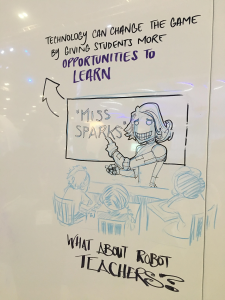BETT Show 2017
As a student, I have never been to a BETT show and therefore did not know what to expect. My initial thoughts was it being a convention with large education related businesses trying to sell their up and coming products. Buckingham recognises this through stating, ‘As the number of teachers leaving the profession has grown… educational technology has become an attractive opportunity for potential entrepreneurs…’ (2011:9). I could relate to this opinion as I personally felt that businesses were there for private interests rather than the focus being primarily open for educational platform. However, there is a contrasting opinion which considers the need of having to sell technology to school in order to enthuse children about ICT. This is stated in the Becta Report, ‘Without some effort to ‘sell’ ICT based learning in this way it is unlikely that young people will force any ‘bottom-up’ change in schools’ uses of ICTs. Pupils clearly have an important role to play in the development of future forms of school ICT use, but it would seem that the lead should be taken by schools and other education technology stakeholders if meaningful change is to be initiated.’ (2008:40). This stance presents that there is a need for commercial advertisement in order for ICT and computing to progressively evolve in schools.
Nevertheless, the experience alone was a beneficial one as there were a range of interesting talks and presentations delivered. Upon arrival, it was easy to sign up as a student and enter the hall. After being phased by the busy and large spread, I decided to wonder. After walking around it was evident to see the variety of technology based products that were up for sale. My perspective on most of the items which were up for sale was that they were unnecessary. Although classrooms do require an element of technology based learning resources, there is no need for items such as a “Robotic Arm Education Kit”, which is essentially an kit which helps bridge children from using coding programs Scratch to more sophisticated areas such as Python. I personally did not see the benefits from an educational perspective, the main focus just seemed to come from a money making stance. However, an area which seemed to be quite popular included the use of interactive and physical approaches to learning through whiteboards. Using projector boards to present games where children can physically move and engage in an activity was interesting to me as it was a tool which could be used across many subjects. This is a strategy which I have seen being used in the children’s area in McDonalds, but until seeing at the BETT show, I never thought about the benefits of introducing the concept in to education. The Alliance for Excellent Education and the Stanford Center for Opportunity Policy in Education (SCOPE) also recognises the advantages of interactive learning and by stating, ‘…that technology – when implemented properly -can produce significant gains in student achievement and boost engagement, particularly among students most at risk.’ (SCOPE:2014)
Whilst at the BETT show I watched a presentation by John Galloway which discussed inclusive approaches to teaching programming.
[embeddoc url=”http://www.bettshow.com/files/day_2_john_galloway.pdf” download=”all” viewer=”google” ]
He discussed how introducing practical activities in to teaching can contribute to a child’s understanding of the concept of coding. For example, asking children to write the directions of their journey to school, this forms an algorithm and develops their understanding of computational thinking. Allowing children to make connections with real life situations is important because coding is a topic many students feel intimidated by. However, incorporating practical activities makes the subject easily relatable. I would personally use this technique, especially for lower KS1 students and is something I would consider planning for during my next BSE placement as I teach in a year 1 class.
One aspect of John Gallway’s presentation particularly interested me. When discussing coding he discussed how ‘coding can be a hands on experience’ and suggested the resource ‘cubetto’ as a prime example of how learning coding does not need to taught through computers. Instead, it’s a playset which is based on touch. A learning resource which would be particularly beneficial for KS1 students.
https://www.youtube.com/watch?v=yBJWKbv589Q&feature=youtu.be
The above example demonstrates that although BETT can be criticised for driving a consumerist market, simple learning tools like this continues to place educational values at the forefront of the conventions philosophy.
My overall experience of the BETT show was that it was interesting to see the different products that are out there, however, I found that many of them are unnecessary and are simply not needed. In terms of the BETT show as a whole, it was busy and many of the stands did not seemed interested in students, they were more interested in making sales to bigger companies. Would I take my future class for a visit? Perhaps upper Key Stage 2 so they could experience the community, especially if there are children who are interested in such products. However, I would ensure to take them to a talk or presentation which would inform their learning.
Sources:
- Buckingham, D. (2011) Beyond Technology, Cambridge: Policy Press
- Becta., (2008) ‘Learners and Technology: 7-11’. Coventry: Becta. http://dera.ioe.ac.uk/1630/ (accessed 20st September 2016)
- Cubetto: https://www.youtube.com/watch?v=yBJWKbv589Q&feature=youtu.be
- Galloway, J. (2017) http://www.bettshow.com/files/day_2_john_galloway.pdf
- Stanford Graduate School of Education (2014) Technology can close achievement gaps, improve learning. Available at: https://ed.stanford.edu/news/technology-can-close-achievement-gaps-and-improve-learning-outcomes

